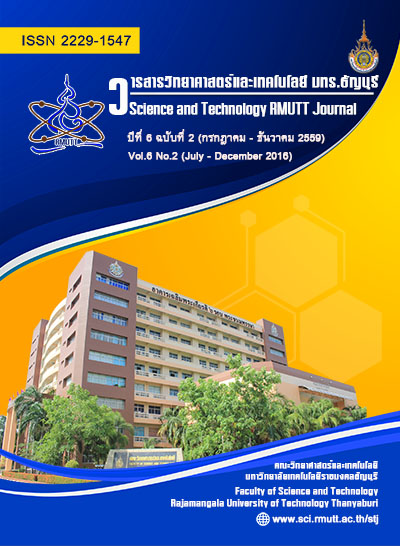Photoelectrocatalytic activity development of copper oxide electrode for hydrogen production under visible light irradiation
Main Article Content
Abstract
In this research, a copper oxide thin film deposited on conducting glass fluorine-doped tin oxide (FTO) was developed. Cuprous oxide (Cu2O) was fabricated by electrodeposition technique and calcination at a high temperature in order to cupric oxide (CuO) fabrication. These copper oxide electrodes were applied for hydrogen production from water splitting with the photoelectrocatalytic principle under visible light irradiation. Absorption properties of the fabricated film electrode were studied by UV/vis spectroscopy technique. Scanning electron microscopy (SEM) and X-ray diffraction (XRD) were used to study the morphologies and crystalline structure, respectively. The photoelectrocatalytic properties of copper oxide electrode for hydrogen production were studied by monitoring a current from the reaction under visible light irradiation. The effect on calcination temperatures was studied to enhance the hydrogen production efficiency. The efficiency of cuprous oxide (Cu2O) for hydrogen production was improved up to 3 times by calcinating to cupric oxide (CuO) with narrower band gap energy effect.
Article Details
References
X. Cheng, Z. Shi, and J. Shen. A review of PEM hydrogen fuel cell contamination: Impacts, mechanisms, and mitigation. J. Power Sources. 165 (2007): 739-756.
K. Maed and K. Domen. Photocatalytic Water Splitting: Recent Progress and Future Challenges. J. Phys. Chem. Lett. 1 (2010): 2655–2661.
G. Wanga, Y. Linga, H. Wanga, X. Lua and Y. Li. Chemically modified nanostructures for photoelectrochemical water splitting. J. photoch. Photobio C. 19 (2014): 35–51.
W. Wang, M. Gu, Y. Jin. Effect of PVP on the photocatalytic behavior of TiO2 under sunlight. Materials Letters 57 (2003): 3276 – 3281.
C. Ponchio, A. Y. Nosaka, and Y. Nosaka. The Effect of Platinum Deposition on the Water Photo-Reduction at p-Cu2O Semiconductor Electrodes with Visible Light Irradiation. Electrochemistry, 79 (10) (2011): 821-825.
H. Pang, J. Deng, B. Yan, Y. Ma, G. Li, Y. Ai, J. Chen, J. Zhang, H. Zheng and J. Du. Cupric Oxide Nanorods on Double-Face Copper Micropuzzles Electrode as Promising Anode Materials for Lithium Ion Batteries. Int. J. Electrochem. Sci. 7 (2012): 10735 – 10747


